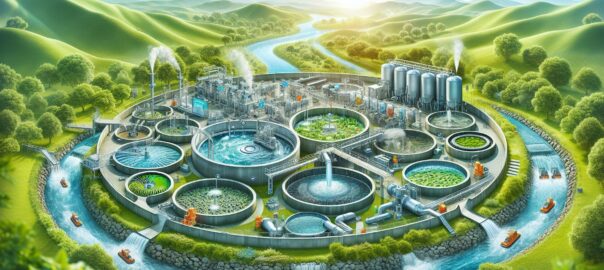Water is the lifeblood of our communities but managing wastewater effectively presents a significant challenge to municipalities and environmental agencies worldwide. One promising solution to meet this challenge is the adoption of Integrated Wastewater Treatment Systems (IWTS). Integration in wastewater treatment involves the combination of various technologies, processes, and management strategies to create a cohesive system that not only treats wastewater effectively but also optimizes performance, reduces costs, and minimizes environmental impacts.
In this comprehensive article, we will explore what integrated wastewater treatment systems are, the benefits they offer, the components that make up these systems, and the key considerations for their implementation. We’ll also delve into the future of IWTS and compare traditional methods with integrated approaches.
What is an Integrated Wastewater Treatment System?
An Integrated Wastewater Treatment System encompasses a unified methodology to manage and treat wastewater from its source to eventual disposal or reuse. IWTS is not just about technological components; it’s also about the holistic management of these components in a strategic framework that maximizes efficiency across the entire wastewater cycle.
Such systems typically include a combination of mechanical, biological, and chemical treatment processes with advanced monitoring, data analytics, and control systems to ensure that water quality meets regulatory standards and supports sustainable practices.
Benefits of an Integrated Wastewater Treatment System
Improved Water Quality
By employing a variety of treatment processes and continuously monitoring outputs, IWTS ensures that the treated water meets the desired quality standards, reducing the risk of environmental contamination and public health hazards.
Cost Efficiency
Integrated systems can lead to significant cost savings by optimizing energy use, reducing waste sludge, and streamlining management practices. Cost efficiency also comes from the long-term view of infrastructure investment and operation.
Enhanced System Performance
The introduction of real-time monitoring and control reduces the risk of system failures and enables a proactive approach to maintenance, thus enhancing overall system performance.
Environmental Sustainability
IWTS is designed with sustainability in mind, aiming to minimize the carbon footprint of wastewater treatment and promote the reuse of treated water, thus conserving valuable water resources.
Regulatory Compliance
As regulations become stricter, an integrated approach provides a versatile and adaptive means to meet current and future regulatory requirements.
Components of Integrated Wastewater Treatment Systems
- Primary Treatment Facilities: Where preliminary screening, sedimentation, and removal of large contaminants occur.
- Secondary Treatment Processes: Biological processes to break down organic matter, typically involving bacteria or other microorganisms.
- Tertiary Treatment Stages: This includes advanced methods like UV disinfection, microfiltration, or nutrient removal strategies that further refine the water quality.
- Monitoring Systems: Sensors and gauges are placed throughout the treatment chain to continuously monitor water quality and operational variables.
- Data Analytics Software: Collects vast amounts of data from sensors and transforms it into actionable insights, leading to informed decision-making.
- Control Systems: Allows operators to adjust treatment processes in real-time based on data analytics.
- Sludge Treatment Facilities: Processes to reduce, treat, and dispose of the byproduct sludge generated during treatment.
- Energy Recovery Units: Systems that capture and reuse energy within the treatment process, contributing to a more sustainable operation.
Key Considerations For Implementation
Assessing Needs and Scale
Prior to embarking on integrating wastewater treatment systems, a comprehensive assessment of community needs, existing infrastructure, and projected growth is required to determine the scale and specifications necessary for effective treatment.
Design and Technology Selection
Identifying the most appropriate technologies and design configurations is a complex process that must consider the specific characteristics of the wastewater, the environmental context, regulatory requirements, and cost implications.
Financing and Budgeting
An integrated wastewater treatment system is a significant financial investment. Securing funding and maintaining a long-term budget for operations and maintenance is crucial for the successful implementation and sustainability of IWTS.
Regulatory Compliance
Keeping abreast of and adhering to local, state, and federal wastewater treatment regulations is a critical aspect that must be integrated into the system’s design and operation.
Training and Workforce Development
Personnel must be adequately trained to manage and operate these complex systems. Investing in workforce development is vital to ensure efficient and effective ongoing system performance.
Public Engagement and Stakeholder Buy-In
Public support and stakeholder engagement are significant components in implementing an IWTS. Educating the community about the benefits and requirements of the new system helps garner support and ensure smooth operation.
The Future of Integrated Wastewater Treatment
The future of wastewater treatment is likely to see greater integration of technology, including the use of artificial intelligence (AI) and the Internet of Things (IoT). These advancements will provide unprecedented levels of system efficiency, real-time response capability, and operational flexibility. With increasing pressure on water resources, IWTS will also focus more on resource recovery, transforming waste into valuable byproducts like biogas, fertilizers, and even potable water.
Traditional Methods vs. Integrated Approaches
Traditional wastewater treatments typically involve a linear, less flexible process. These conventional systems can be less adept at handling fluctuations in input loads and water quality. In contrast, integrated systems are designed to be more adaptive, providing greater resilience against varying conditions and inputs.
Sources for Further Reading:
-
EPA – The United States Environmental Protection Agency offers detailed insights into wastewater management, treatment technologies, and best practices. (EPA Wastewater Technology)
-
Water Environment Federation (WEF) – WEF provides valuable resources on the latest developments in water quality, technology, and treatment. (WEF Publications)
-
United Nations Environment Programme (UNEP) – UNEP has several reports and publications that discuss the importance of integrated water management and its role in sustainable development. (UNEP Water Quality)
The path to clean water and a sustainable future lies in the integration of technologies, data-driven insights, and community engagement in wastewater treatment processes. Integrated Wastewater Treatment Systems represent a powerful tool that can help us walk that path, meeting the challenges of today’s demand for water and creating a cleaner, safer environment for generations to come.
